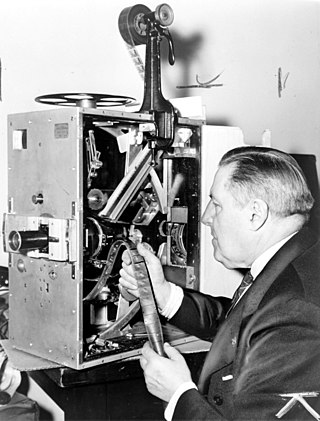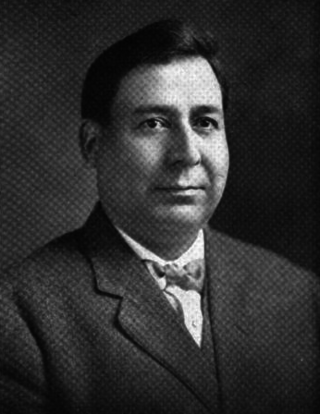Related Research Articles

Gottfried Wilhelm Bitzer was an American cinematographer, notable for his close association and pioneering work with D. W. Griffith.
The year 1900 in film involved some significant events.

The Mutoscope is an early motion picture device, invented by W. K. L. Dickson and Herman Casler and granted U.S. patent 549309A to Herman Casler on November 5, 1895. Like Thomas Edison's Kinetoscope, it did not project on a screen and provided viewing to only one person at a time. Cheaper and simpler than the Kinetoscope, the system, marketed by the American Mutoscope Company, quickly dominated the coin-in-the-slot peep-show business.

The Biograph Company, also known as the American Mutoscope and Biograph Company, was a motion picture company founded in 1895 and active until 1916. It was the first company in the United States devoted entirely to film production and exhibition, and for two decades was one of the most prolific, releasing over 3000 short films and 12 feature films. During the height of silent film as a medium, Biograph was the most prominent U.S. film studio and one of the most respected and influential studios worldwide, only rivaled by Germany's UFA, Sweden's Svensk Filmindustri and France's Pathé. The company was home to pioneering director D. W. Griffith and such actors as Mary Pickford, Lillian Gish, and Lionel Barrymore.

The United States Indian Industrial School in Carlisle, Pennsylvania, generally known as Carlisle Indian Industrial School, was the flagship Indian boarding school in the United States from its founding in 1879 through 1918. It was based in the historic Carlisle Barracks, which was transferred to the Department of Interior from the War Department for the purpose of establishing the school. More than 7,800 children from 140 Indian tribes were separated from their communities and sent to the school. After the United States entered World War I, however, the school was closed, and the property on which it was located was transferred back for use by the U.S. Department of Defense. The property is now part of the U.S. Army War College, and it was designated a national monument by President Joe Biden in December 2024. Carlisle Federal Indian Boarding School National Monument will be co-managed by the Army and the National Park Service in consultation with tribes.

Herman Casler was an American inventor and co-founder of the partnership called the K.M.C.D. Syndicate, along with W.K-L. Dickson, Elias Koopman, and Henry N "Harry" Marvin, which eventually was incorporated into the American Mutoscope Company in December 1895.

Sherlock Holmes Baffled is an American silent trick film created in 1900 with cinematography by Arthur Marvin. It is the earliest known film to feature Arthur Conan Doyle's detective character Sherlock Holmes, albeit in a form unlike that of later screen incarnations. In the film, a thief who can appear and disappear at will steals a sack of items from Sherlock Holmes. At each point, Holmes's attempts to thwart the intruder end in failure.

The Taming of the Shrew is a 1908 silent film directed by D. W. Griffith and produced by the American Mutoscope and Biograph Company of New York City. The 17-minute short, which is based on the play of the same name by English playwright William Shakespeare, was filmed in just two days–October 1 and 7, 1908–at Biograph's studio in Manhattan and on location in nearby Coytesville, a borough of Fort Lee, New Jersey.
Arrival of Tongkin Train, also referred to as Arrival of Train, Tien-Tsin, is a 1901 documentary silent film showing the arrival of a train in Tianjin, China. The film was made by American Mutoscope and Biograph Company.

McKinley at Home, Canton, Ohio aka William McKinley at Canton, Ohio is a silent film reenactment of William McKinley receiving the Republican nomination for President of the United States in September 1896. The actual nomination had been several weeks earlier. McKinley is shown emerging from his house to receive the news from his secretary George Cortelyou. His wife Ida can be seen in a rocking chair on the porch. McKinley is seen removing his hat and wiping his forehead with a handkerchief after receiving the news. It was filmed by a two-man crew for American Mutoscope and Biograph Company on 68 mm film, 60.02 m in length. McKinley's brother Abner and former US president Benjamin Harrison were stockholders in the film company.
Frederick S. Armitage was an early American motion picture cinematographer and director, working primarily for the American Mutoscope and Biograph Company. Often identified as "F.S. Armitage" in AM&B paperwork, Armitage had a hand in creating more than 400 often very short subjects for AM&B in the days where its films were made as much for the hand-crank operated Mutoscope device as for projection. Several of Armitage's subjects stand out from the company's regular routine of actualities and comic skits in their innovative use of camerawork, superimpositions, time-lapse photography and other effects then new to the art of film-making.

Dark Cloud was a First Nations silent film actor, born Elijah Tahamont. He was a chief of the Abenaki, a First Nations band government belonging to the Eastern Algonquian peoples of northeastern North America.

The Call of the Wild is a 1908 American short silent Western film directed by D. W. Griffith and produced by the American Mutoscope and Biograph Company. The short, a "one-reeler", stars Charles Inslee, Harry Solter and Florence Lawrence. Its interior scenes were shot at Biograph's studio facilities in New York City, and its exteriors were filmed on location in Coytesville, today one of the oldest communities in Fort Lee, New Jersey.
The Girl and the Outlaw is a 1908 American silent short Western film directed by D. W. Griffith for American Mutoscope & Biograph Company. It starred Charles Inslee as the outlaw but other members of the cast are largely unconfirmed. Florence Lawrence and Mack Sennett made early appearances.
The Zulu's Heart is an extant 1908 American silent short drama film directed by D. W. Griffith for the American Mutoscope and Biograph Company. Location footage was shot in Cliffside, New Jersey. White actors in blackface portray Zulus.

Dennison Wheelock was an Oneida band conductor, composer, and cornet soloist. Wheelock was the most prominent Indian American band leader of the turn of the century and was nominated to serve as the bandmaster of the United States Marine Band. At the age of 40 he became an American Indian rights activist and attorney, and within several years was arguing cases for Indian nations at the United States Court of Claims and US Supreme Court.
The Mended Lute is a 1909 American short silent Western film directed by D. W. Griffith and starring Florence Lawrence. It was produced by the American Mutoscope and Biograph Company.
The Pioneers is an American silent film and one of the earliest Westerns, having been released by the American Mutoscope and Biograph Company in October 1903. It incorporates part of the footage from Kit Carson, another Western short also released by Biograph in October 1903. Both films were shot on location in the Adirondack Mountains of New York.

The Moonshiner is a 1904 American short silent action film produced by the American Mutoscope & Biograph Company and directed by Wallace McCutcheon, Sr.
References
- ↑ Joanna Hearne, Native Recognition: Indigenous Cinema and the Western (2012) p 372